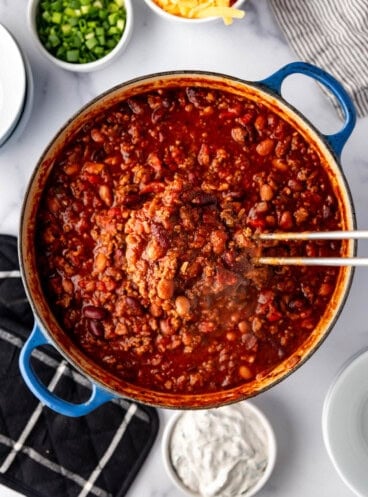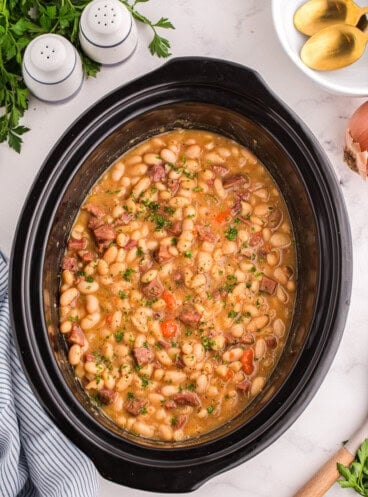New Mexican Posole is a delicious and comforting soup loaded with chunks of pork and hominy in a smoky, rich broth. The flavors in this traditional Mexican and Southwest soup are out-of-this world and perfect for a cozy homecooked dinner, whether you are serving it at Christmas time or any night of the year.
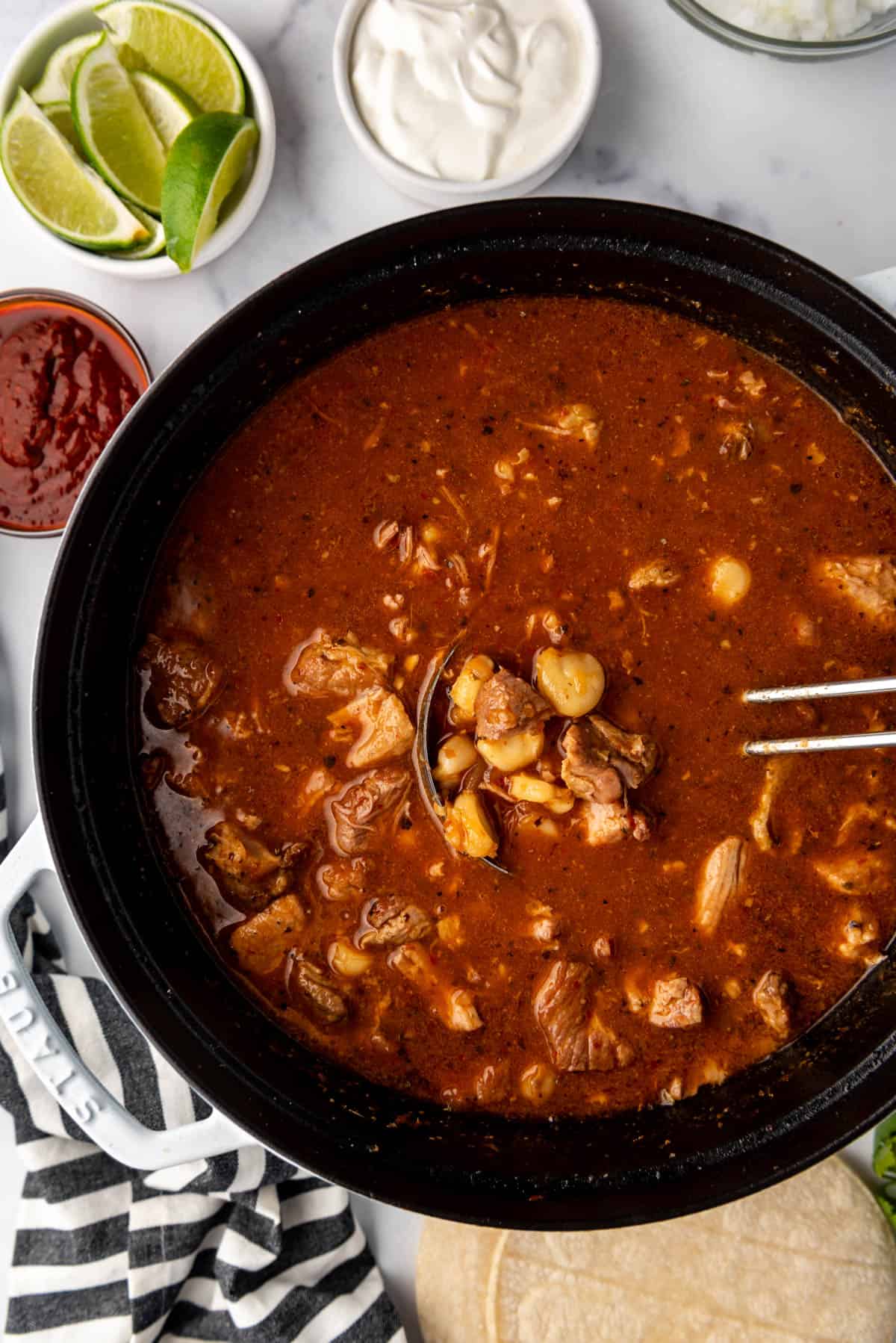
I did a lot of research to try to come up with an authentic New Mexico posole recipe to represent the “Land of Enchantment” for my American Eats series. There are lots of variations when it comes to posole, which at its heart is a robust, earthy soup with cooked hominy as the predominant flavor. That includes a green chicken posole version that is popular in Mexico and even New Mexico, but for many New Mexican families this red posole with pork (aka Pozole Rojo) is a beloved holiday dish that is primarily eaten around Christmas. But it is so good that it’s a shame to not enjoy it the rest of the year and there is no rule saying you can’t!
I have made dozens of soups and stews over the years and I have to say that this one has an almost unparalleled depth of flavor, especially coming from such a surprisingly short list of ingredients. It’s pretty incredible how you can achieve so much complexity in one pot.
What sets this homemade posole recipe apart is the use of dried hominy that you soak overnight for a texture and flavor that is far superior to canned hominy like so many other recipes call for. Sure it is an extra step, but it’s absolutely worth it for a real taste of this New Mexico favorite.
PRO TIP: I recommend that you resist the temptation to go overboard on toppings. Some folks add thinly sliced cabbage, radishes, queso fresco, avocado, crema, and other garnishes to their posole (yes, even in New Mexico). While delicious, most of the sources I found claim that true New Mexican posole keeps garnishes simple with just some diced white onion, fresh cilantro, and maybe a squeeze of lime. I tried it both ways to be thorough in my recipe testing and can honestly say that the additional toppings detracted from the homey, warm flavor of the posole, which really ought to be the star of the show anyway. Obviously serve it how you like it, but keep this in mind for an authentic experience!


Ingredient Overview
This section is meant to give you a lay-of-the-land for the important ingredients you’ll want to pick up from the store to make my red posole recipe. Scroll to the printable recipe card for the exact measurements and instructions.
- New Mexican Dried Chiles: New Mexico is famous for its chiles and a bag of dried red chile peppers grown in New Mexico will give you the most authentic flavor for your posole. They can vary in heat and flavor, but they are generally a mild to medium heat with a complex flavor that is both earthy and slightly sweet. You will find these used widely in New Mexican cuisine.
- Dried Hominy: These large corn kernels are treated with alkali and dried. They need to be soaked and simmered until tender before using in posole, where it has a chewy texture with a deep, nutty flavor that marries perfectly with the rich broth and spices of the soup.
- Pork Shoulder or Pork Butt: This finely marbled cut of pork will cook up tender and add a richness to the broth that you won’t get from leaner cuts of pork like pork loin.
- Chicken Broth: Some recipes use just water to create the base of the soup, but I found that chicken broth creates a more robust backdrop for better flavor without overpowering the hominy, pork, or chiles.
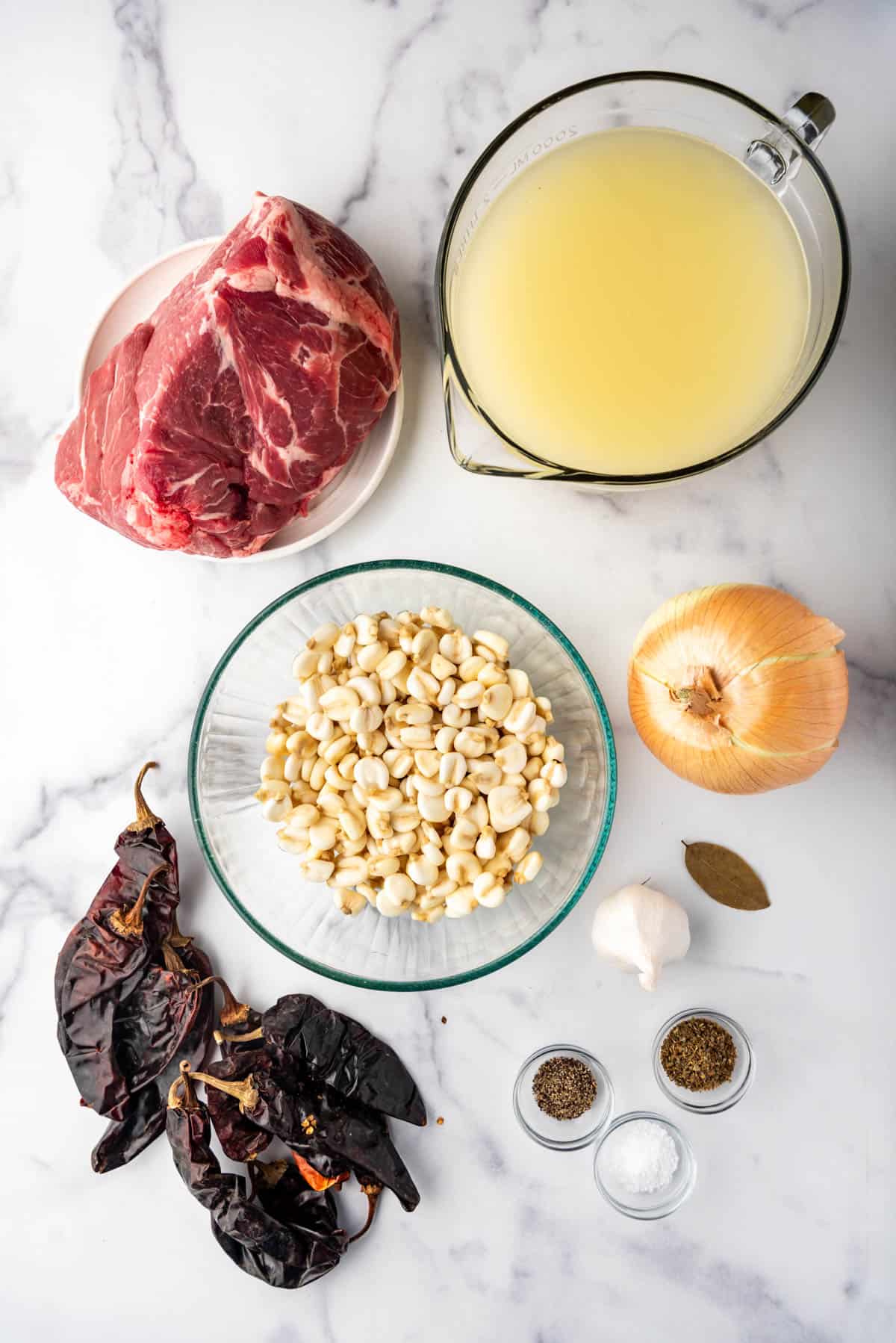
How to Make Posole
If you want a visual representation of the process, here are some step-by-step photos to walk you through it. The full instructions are written out below in the recipe card.
- Soak the hominy overnight. The only downside of using dried hominy is you need to soak it in cold water overnight. Once it has thoroughly soaked, drain the hominy, then cover it with fresh water and bring to a boil over medium-high heat. Reduce to medium-low and then let it simmer for 1 hour or just until the kernels have started to pop. Drain well then set aside.
- Toast the dried chiles. While the hominy soaks, lightly toast the dried chiles in a dry cast-iron skillet or dutch oven over medium-high heat until fragrant, about 3-4 minutes, turning occasionally so they don’t burn. This dry-roasting process helps wake up their flavors. Remove the chiles from the skillet and use kitchen shears to cut them open, removing and discarding the stems and seeds.
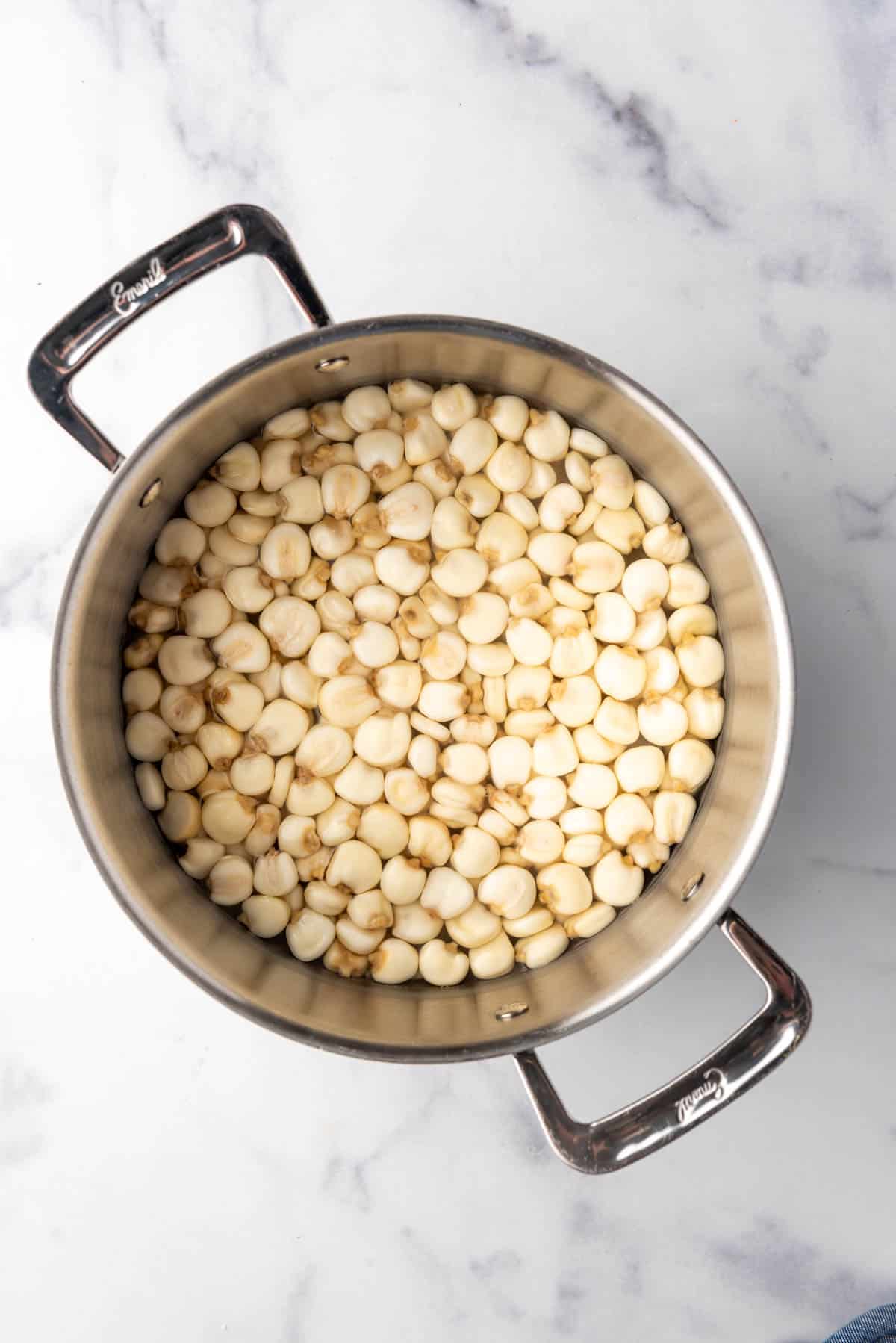
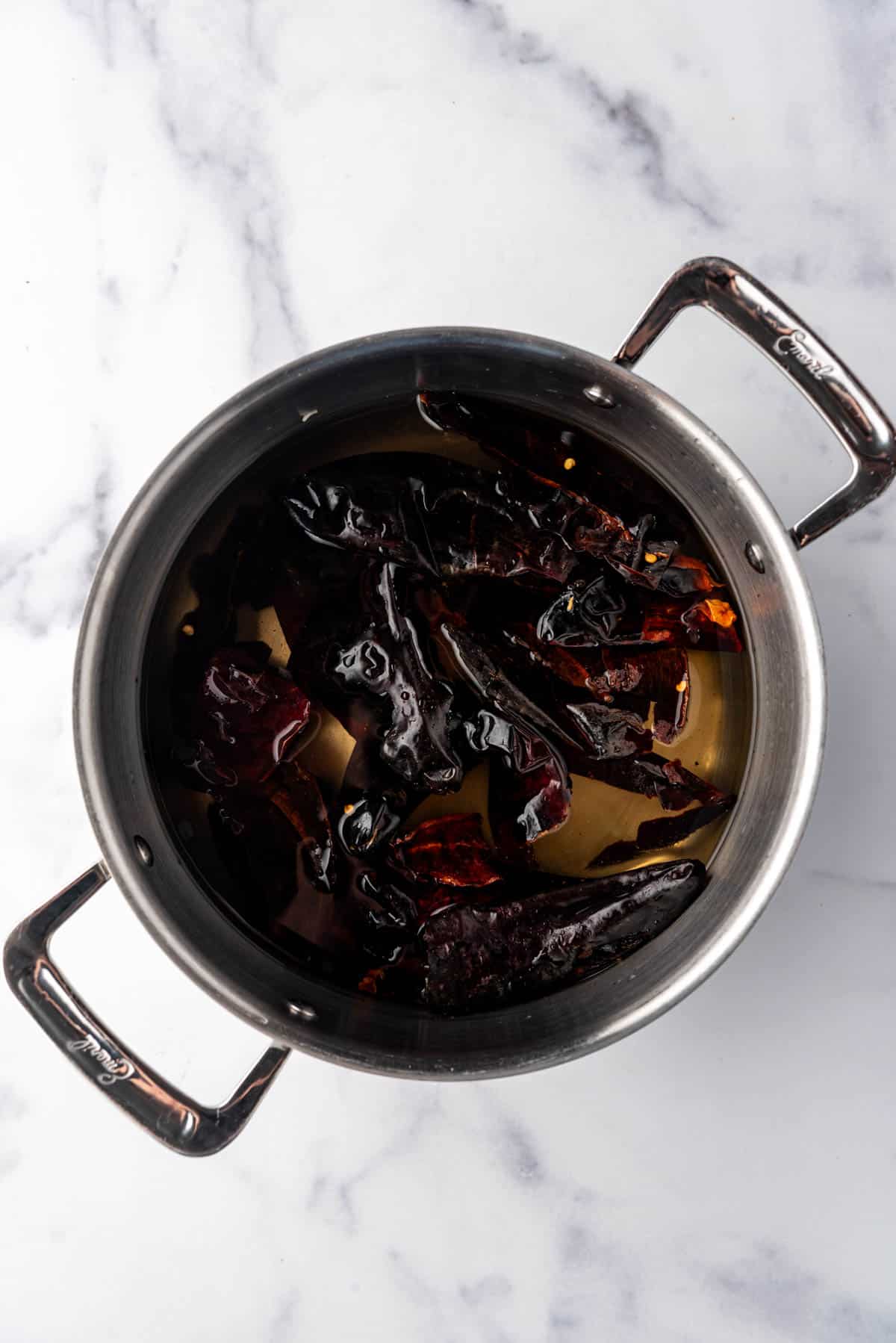
- Make the chili paste. Transfer the chiles to a medium saucepan and cover with about 4 cups of water. Bring everything to a simmer over medium heat for about 30 minutes until the chiles are softened and hydrated. Transfer the chiles to a blender along with just enough of the reserved chili water to blend everything into a smooth paste. I use about 1 cup of the soaking water from the chiles until it is about the consistency of a chimichurri sauce or thick milkshake. Set aside. This step can be done well in advance and stored in the fridge for 1-2 weeks or frozen for up to 3 months.
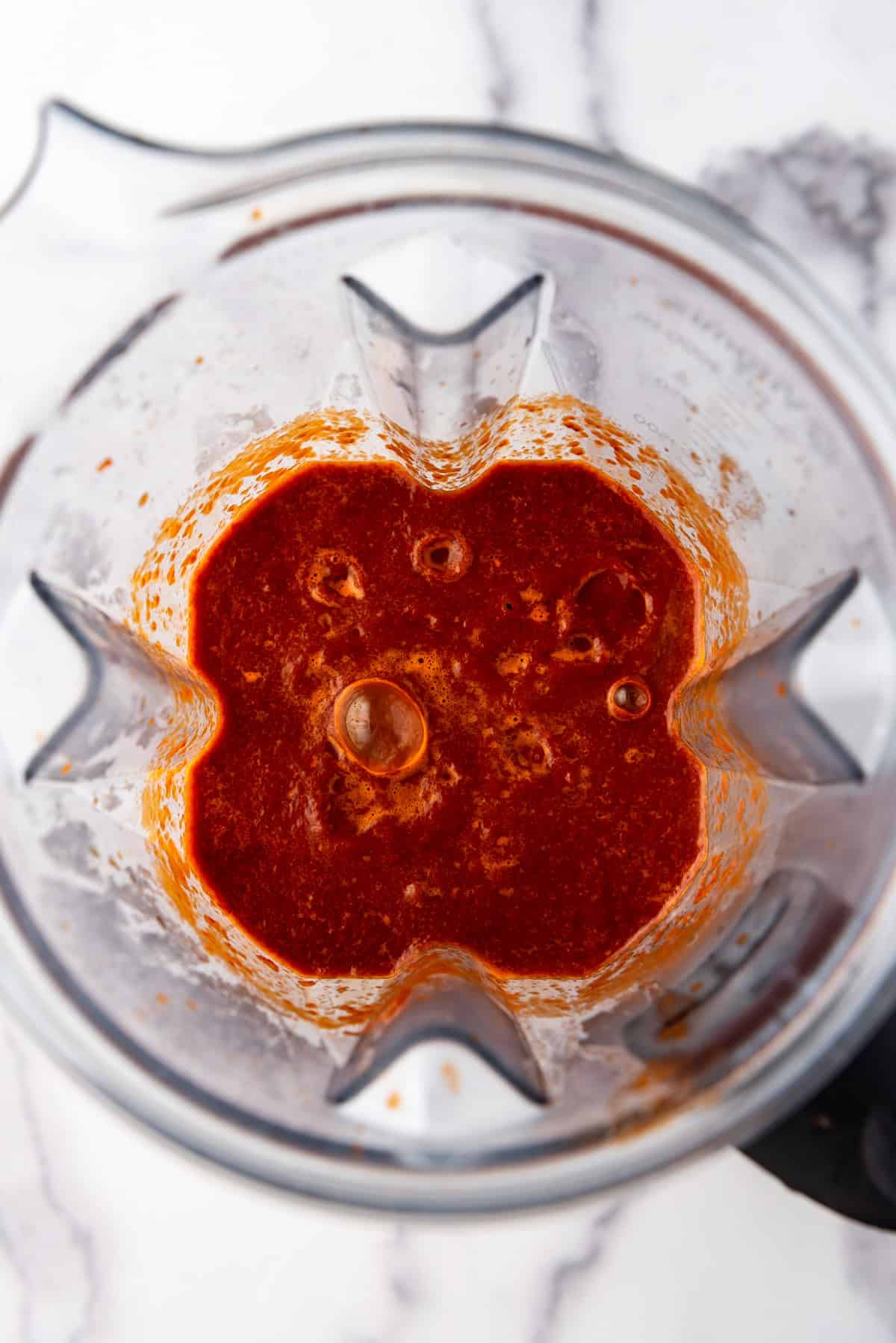
- Sear the pork. Use a very sharp knife to cut the pork shoulder down into 2-inch pieces, then season well with salt and pepper. Heat a drizzle of oil in a large dutch oven over medium-high heat, then work in batches to sear the pork on all sides until nicely browned but not cooked through. Transfer the meat to a plate and set aside.
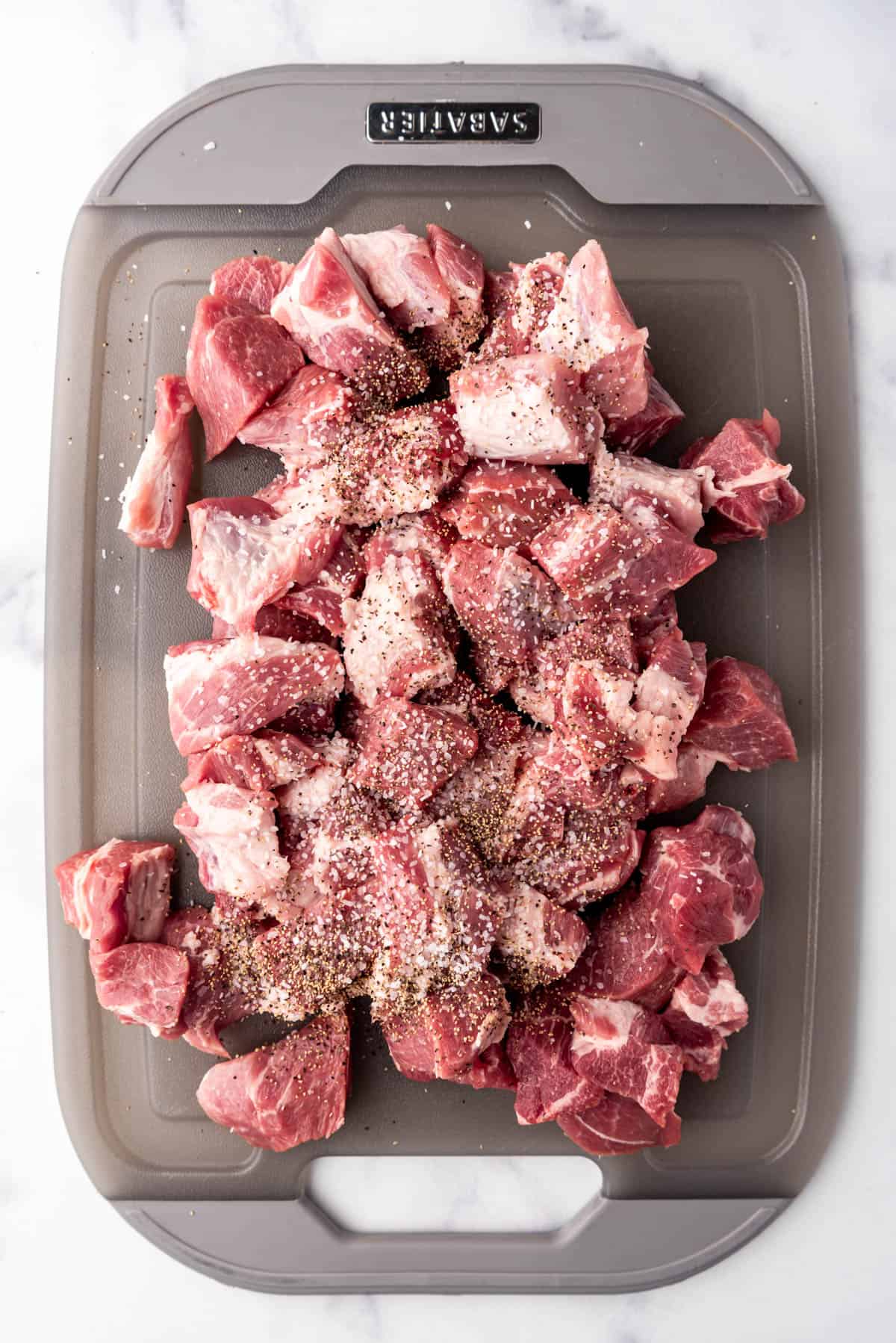
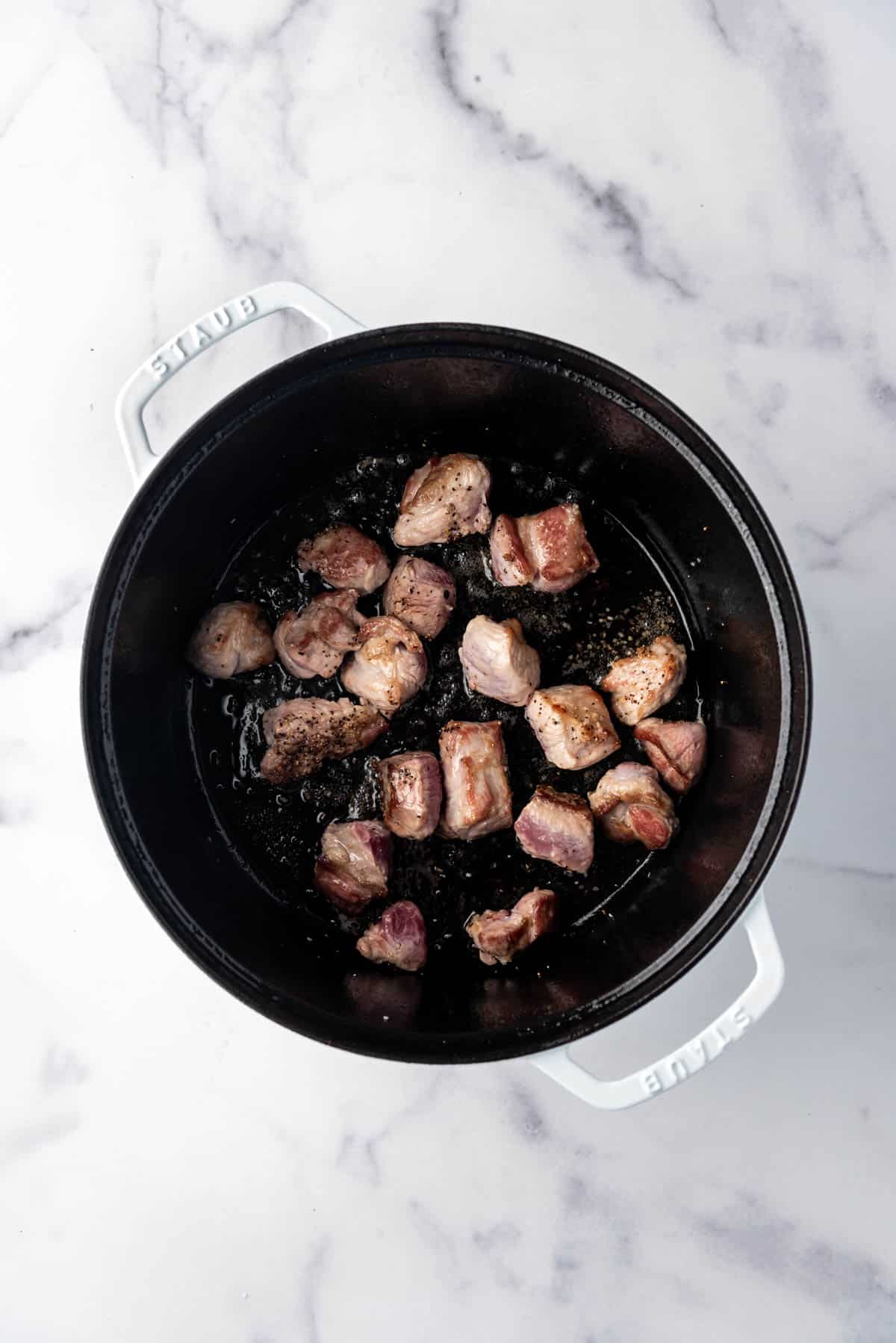
- Saute onions. Add the onion to the same pot and sautee for 3-4 minutes to soften slightly, scraping up any browned bits from the bottom of the pan. Add the garlic and cook for another 30 seconds.
- Add hominy and pork. Return the seared pork and drained hominy to the pot along with the softened veggies.
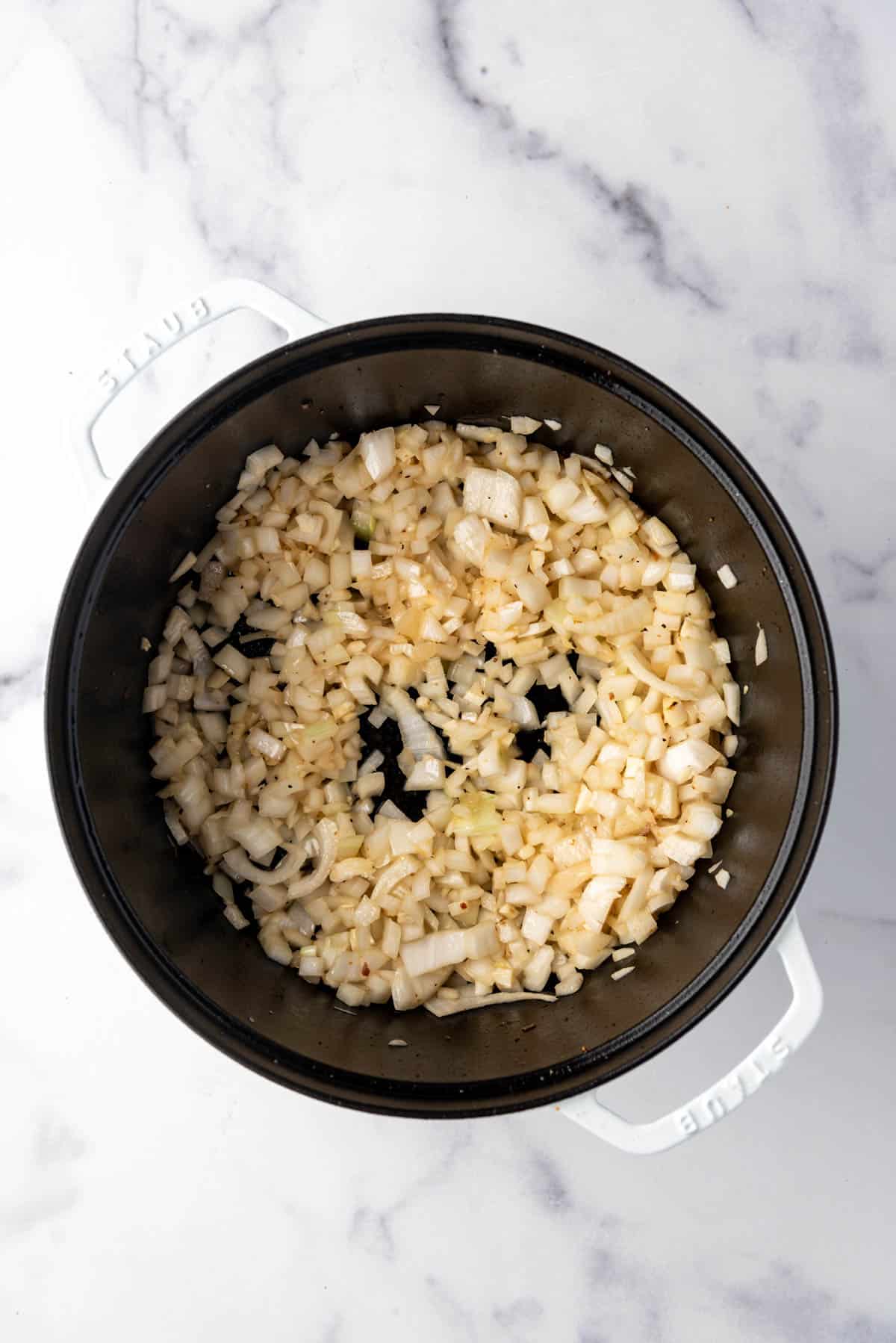
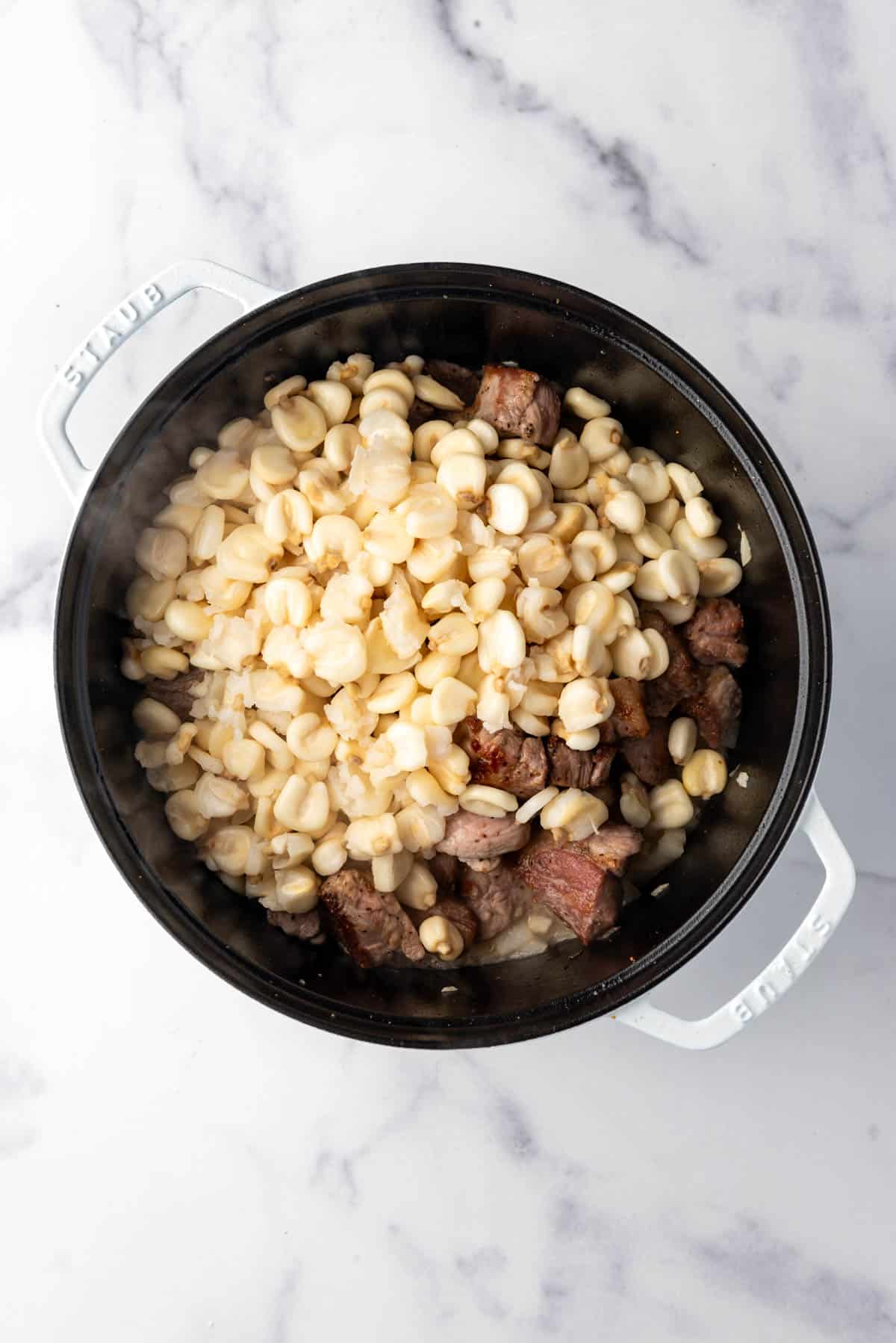
- Simmer. Add the chicken broth, water, bay leaf, and oregano. Bring to a simmer, then cover and cook for 2 ½ hours, adding water if needed, until the meat is fall-apart tender and the hominy has burst. Skim off any fat or foam from the top of the posole as it cooks.
- Adjust seasoning. Toward the end of cooking, stir in 1 cup of the chili puree and let the posole continue to simmer for another 15 minutes. Taste and adjust seasoning with additional salt and pepper or more of the chili puree, as needed. You can also serve the extra chili puree in a bowl on the table for people to add to their posole as they like or freeze it for future use.
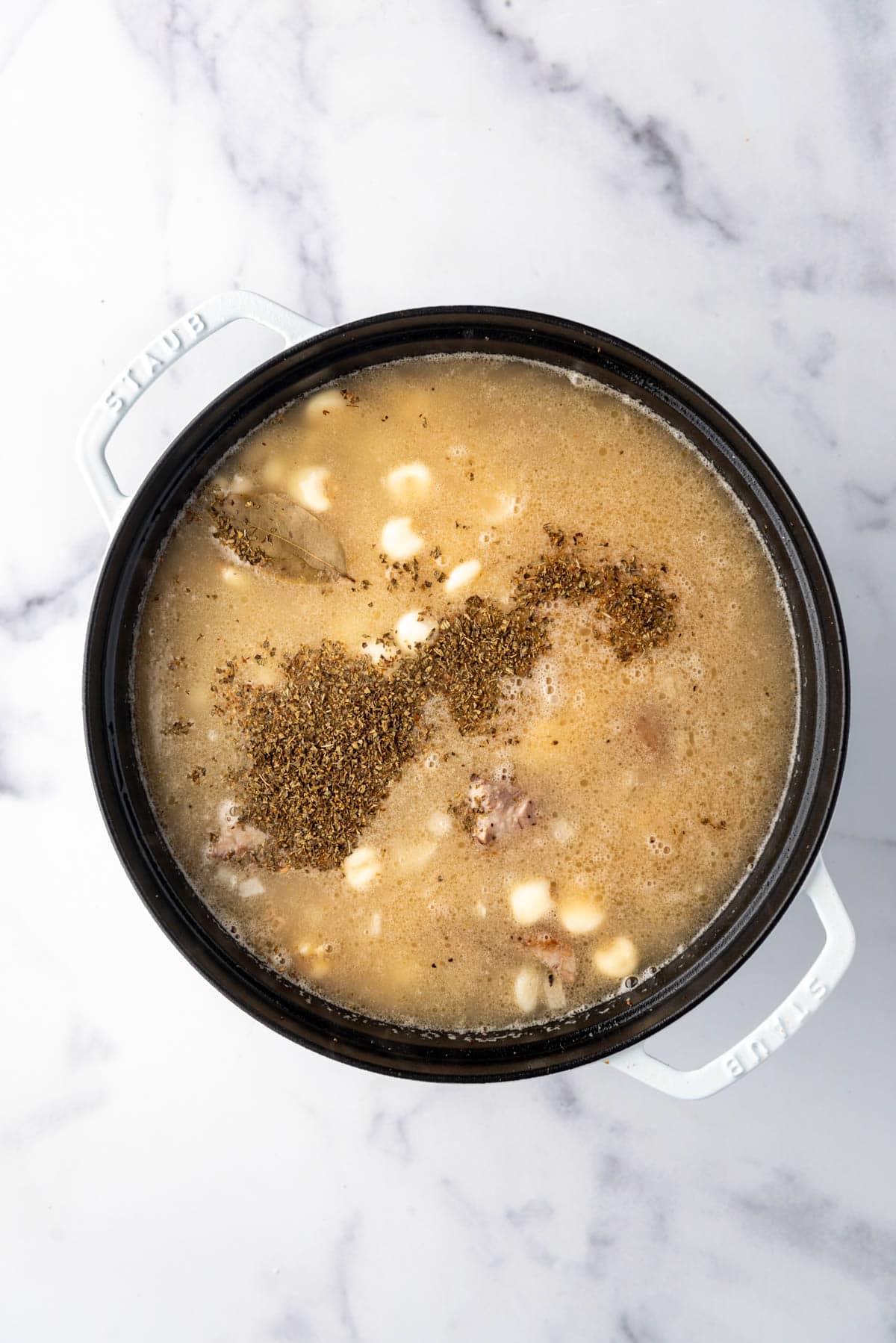
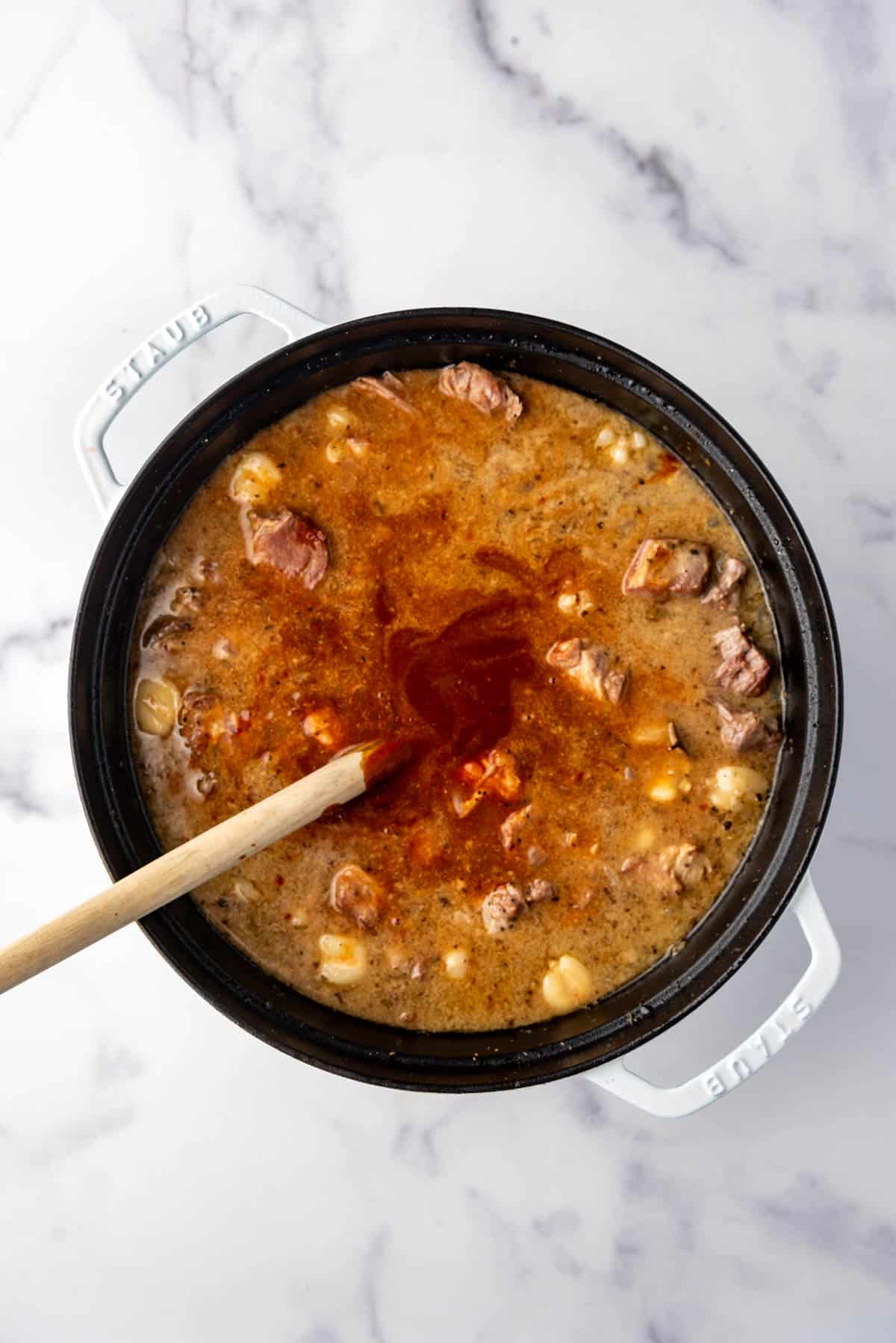
- Serve. Serve the hot posole with diced white onion, fresh cilantro leaves, and lime wedges with corn or flour tortillas on the side for dipping into the posole. Some folks also like to serve queso fresco, thinly sliced green cabbage, thinly sliced radishes, sliced avocado, and Mexican crema for adding to the top of their bowls of posole. We tried it both ways and personally I prefer to stick with just onion, cilantro, and lime.
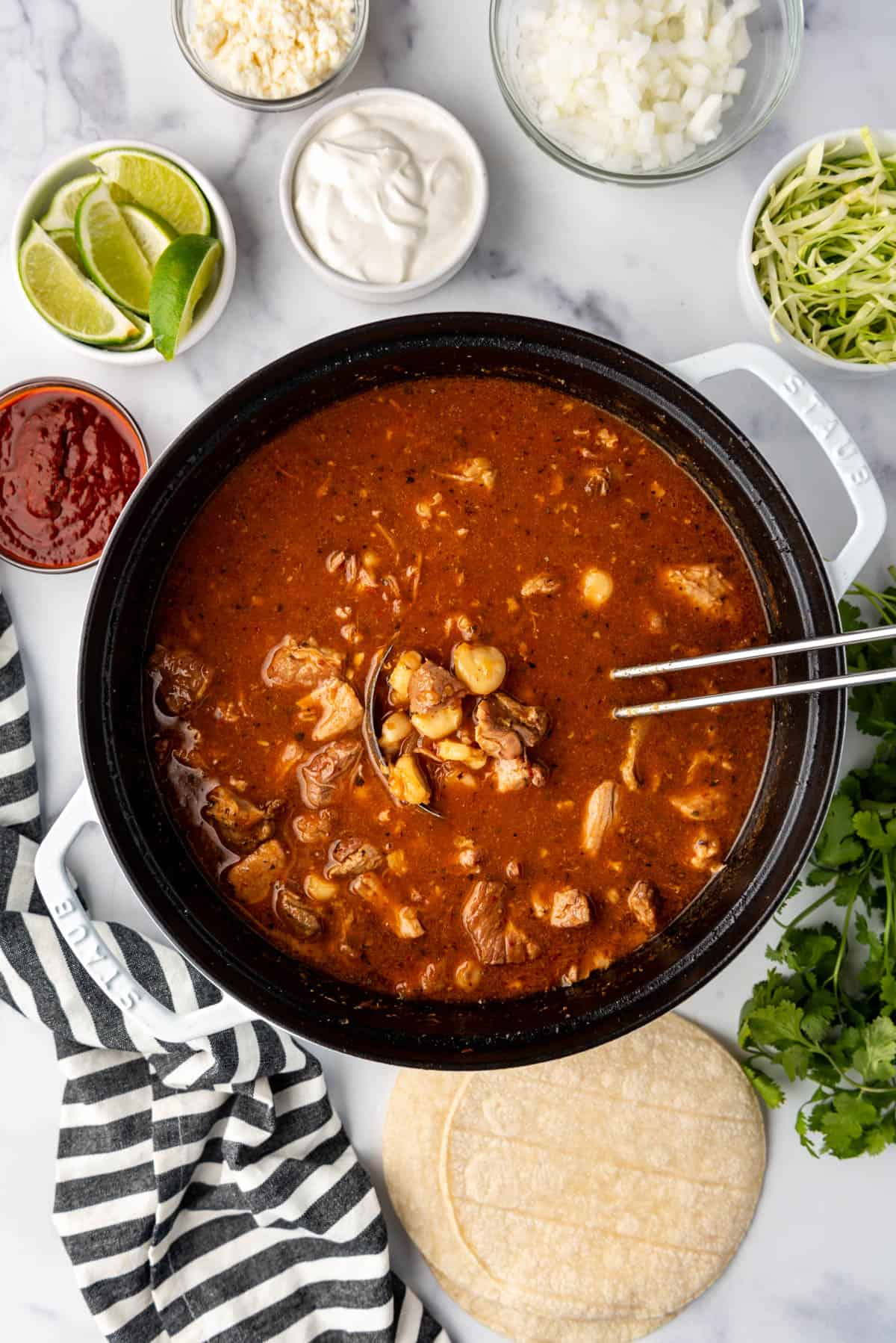

Recipe FAQ’s
I haven’t had a problem finding them in my local grocery store in the Hispanic food aisle, but you might need to order online depending on where you live. If you can’t find New Mexico dried chilies, you can substitute with California chilies for a milder but less complex flavor or Guajillo chilies which are slightly fruitier with a bolder heat than New Mexican dried chiles. However, New Mexican varieties have a unique flavor that’s pretty integral to traditional dishes like red chile sauce and carne adovada.
Yes, you can make this recipe with 2-3 cans of canned hominy that has been drained well if that is what you have on hand or you cannot find dried hominy. I don’t find the texture to be quite as nice with canned hominy, but it works in a pinch.
Either spelling is actually correct. In most regions of Mexico, you will see it spelled with a “z”, but in New Mexico it’s most common to spell posole with an “s”.
Green chicken pozole is another common variation on this hearty stew that is made with chicken instead of pork and flavored with tomatillos and jalapenos instead of dried red chiles, among other differences.
Yes, this soup does great being frozen for up to 2-3 months. I like to freeze it in individual size containers for easier reheating so I can pop it out, thaw, and reheat whenever I want a smoky, hearty lunch full of warm, comforting flavor and mild spice.

Storage Suggestions
To store any uneaten posole, let it cool then transfer to a container with a lid and refrigerate for 3-4 days. The hominy has a tendency to absorb some of the broth, so you might find that you need to add a little additional water to help thin it out when reheating over mild heat on the stovetop or in the microwave.

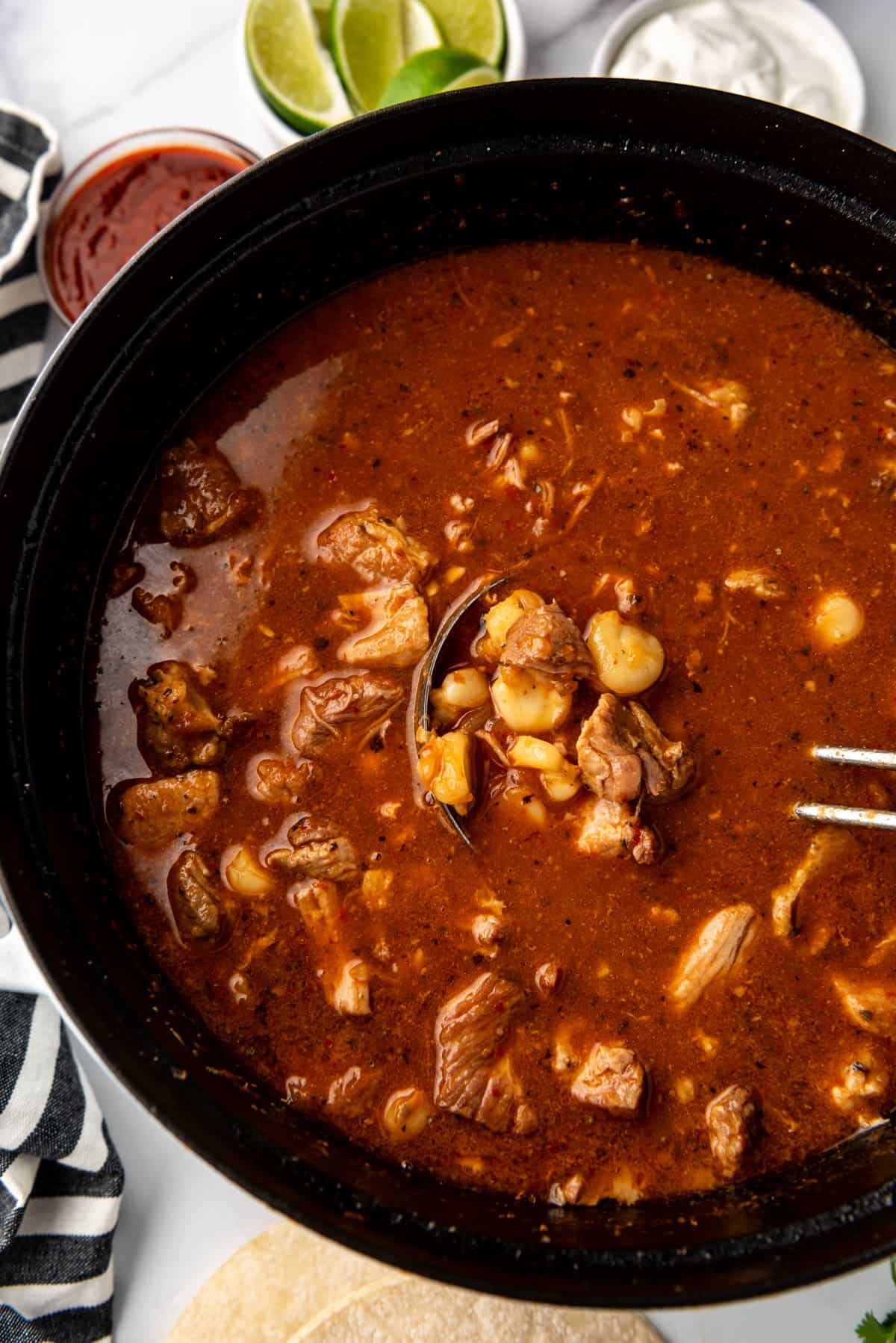
More Soup Recipes
If you love good hearty soups that are packed with textures and flavors and hearty enough for a meal, here are some other favorites to try next!
- Cheesy Chicken Tortilla Soup
- Chicken Pot Pie Soup
- Crockpot Pork Green Chili Stew
- Best Homemade Chili
- Cheeseburger Soup with Bacon
New Mexican Posole
Ingredients
- 1 1/2 pounds dried hominy soaked overnight in cold water
- 10-12 dried red New Mexico chiles (about 3-4 ounces)
- 2-3 pounds boneless pork shoulder or pork butt, cut into 2-inch chunks
- 1-2 teaspoons kosher salt
- 1/2 teaspoon black pepper
- 2 Tablespoons vegetable oil
- 1 large yellow onion chopped
- 6 cloves garlic minced
- 8 cups chicken broth
- 4 cups water
- 1 bay leaf
- 1 1/2 Tablespoons Mexican oregano
- Fresh cilantro leaves, diced white onion, and lime wedges for serving
Instructions
- Add the dried hominy to a large bowl and cover completely with cold water to soak overnight.1 ½ pounds dried hominy
- Drain hominy and transfer to a large pot. Cover with water and bring to a boil over medium-high heat. Reduce to medium-low and let simmer for 1 hour or just until the kernels have started to pop. Drain and set aside.
- Meanwhile, lightly toast the dried chiles in a cast-iron skillet or dutch oven over medium-high heat until fragrant, about 3-4 minutes, turning occasionally. Remove from the skillet and transfer to a cutting board. Use kitchen shears to cut the chiles open and remove and discard the stems and seeds from the chiles. Transfer the chiles to a medium saucepan and cover with 4 cups of water. Heat to a simmer over medium heat, then simmer for 30 minutes. Transfer the softened chili peppers to a blender and blend into a smooth paste by adding as much of the reserved chili water as needed to get a consistency you like. I use about 1 cup of the soaking water from the chiles until it is about the consistency of a chimichurri sauce or thick milkshake. Set aside. This step can be done 1-2 weeks in advance and stored in the fridge or frozen for up to 3 months in the freezer.10-12 dried red New Mexico chiles
- Season the pork with the salt and pepper.2-3 pounds boneless pork shoulder, 1-2 teaspoons kosher salt, ½ teaspoon black pepper
- Heat the vegetable oil in a large dutch oven or pot over medium-high heat. Working in batches so as not to crowd the pan, sear the seasoned chunks of meat on all sides until nicely browned but not cooked through. Transfer the meat to a plate and set aside.2 Tablespoons vegetable oil
- Add the onion to the same pot and sautee for 3-4 minutes to soften slightly, scraping up any browned bits from the bottom of the pan. Add the garlic and cook for another 30 seconds.1 large yellow onion, 6 cloves garlic
- Return the seared pork to the pot along with the hominy and add the chicken broth, water, bay leaf, and oregano. Bring to a simmer, then cover and cook for 2 ½ hours, adding water if needed, until the meat is fall-apart tender and the hominy has burst. Skim off any fat or foam from the top of the posole as it cooks.8 cups chicken broth, 4 cups water, 1 bay leaf, 1 ½ Tablespoons Mexican oregano
- Stir in 1 cup of the chili puree and let the posole continue to simmer for another 15 minutes. Taste and adjust seasoning with additional salt and pepper or more of the chili puree, as needed.
- Serve with diced white onion, fresh cilantro leaves, and lime wedges with corn or flour tortillas on the side for dipping into the posole. Some folks also like to serve queso fresco, thinly sliced green cabbage, thinly sliced radishes, sliced avocado, and Mexican crema for adding to the top of their bowls of posole. Personally I prefer to stick with just onion, cilantro, and lime.Fresh cilantro leaves, diced white onion, and lime wedges
Notes
- Hominy: I usually find this in my regular grocery store in the Hispanic aisle, but you can also get it in Latino grocery stores or order it online.
- Canned Hominy: I do not recommend making this with canned hominy, because the texture isn’t the same, but you can use 2-3 cans of canned hominy if that’s what you already have on hand.
- Chiles: I can find bags of dried chiles in my local grocery store, but you can also find them at Latino grocery stores or order online. Look for New Mexico chiles or guajillo chiles. Other dried chiles like ancho chiles, pasilla chiles, and chiles de arbol can also be used, but they will result in a slightly different flavor profile.
- Storage & Freezing: Posole reheats well. You can refrigerate for 3-4 days or freeze for up to 2-3 months.

